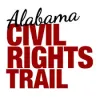Take a look inside 4 images
Alabama Civil Rights Trail
Pros: Well-organized design helps students quickly find information about key people, places, and events related to the U.S. Civil Rights Movement in Alabama.
Cons: Lacks audio or video to break up the text and make the material more engaging.
Bottom Line: Although most information focuses specifically on Alabama, students gain a thorough understanding of key players, places, and events of the entire Civil Rights Movement.
Alabama Civil Rights Trail offers teachers a versatile resource for teaching about the Civil Rights Movement. Teachers in flipped classrooms might have students read about a particular town or group of people to prepare for the next day's class, while those in more traditional classrooms might use portions of the app for whole-class or small-group reading activities. Teachers may also opt to have students complete mini-research projects, assigning small groups of students one of the towns or cities in the app and asking them to prepare a short presentation for the rest of the class.
While not limited to use by teachers in Alabama, those who teach in the state or near its borders may benefit most, using the app to plan field trips to some of the key historical sites or encouraging students to visit those sites with their families.
Created by the Alabama Tourism Department, the Alabama Civil Rights Trail seeks to educate students about Alabama's role in the U.S. Civil Rights Movement. Students tap the name of a city or town in Alabama to read a brief overview of that location's role in the Movement, discover pictures and descriptions of events that took place there, learn the names of key players who lived or visited there, and find sources of additional information. Although much of the information focuses on cities and towns in Alabama, the app also offers short biographies of key players in the Civil Rights Movement with ties to the state, including Rosa Parks, Gov. George Wallace, and Jesse Owens. Students can also see all these events and people in the context of a larger timeline, starting with the Scottsboro Boys Case in 1931 and ending with the awarding of the Congressional Medal of Honor to the four little girls killed in the 1963 bombing of the 16th Street Baptist Church in Birmingham.
Although the text and photographs have a bit of a textbook feel, teachers will have a hard time finding another resource so chock-full of information about the people and events of the U.S. Civil Rights Movement. Not only will students recognize many of the names here, including Martin Luther King Jr. and Rosa Parks, they'll also learn the names of less famous individuals who died in the fight for equality, such as Virgil Lamar Ware and Carole Robertson. They'll then have the opportunity to connect the names of these individuals with specific locations and events, helping them better understand the reality of the U.S. Civil Rights Movement.











